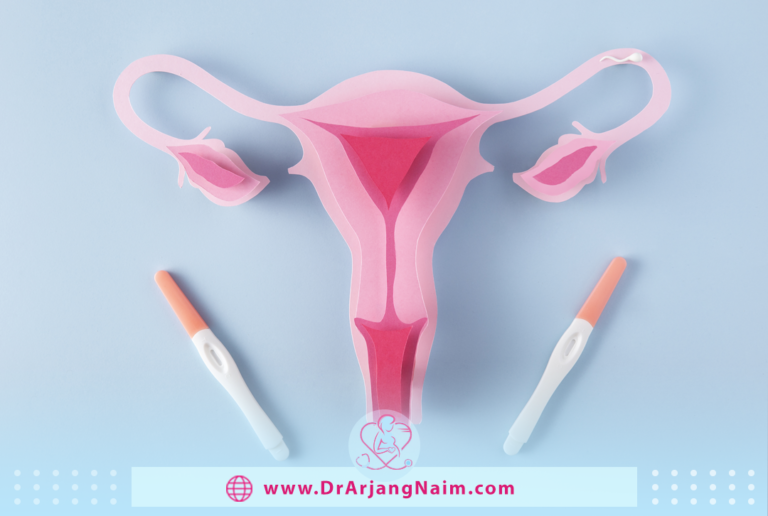Blocked Fallopian Tubes are one of the possible causes of infertility. There are usually no symptoms, but some risk factors can increase your chances of developing the disease.
Fallopian tubes are muscular tubes lined with fine hair-like structures. These hairs work both ways: they help the egg move from the ovaries to the uterus and help the sperm move from the uterus.
Each fallopian tube ends in fimbriae, which are finger-like structures. When the ovary releases it, the fimbriae capture and guide the egg.
The fallopian tubes play an important role in fertilization because they are where most eggs are fertilized. If any part of the fallopian tube is damaged, such as surgery or infection, it can become blocked.
Fallopian tube blockage symptoms
Blocked fallopian tubes often cause no symptoms. Many women do not know that their tubes are blocked until they try to get pregnant and experience problems.
In some cases, blockage of the fallopian tubes can lead to mild, regular pain on one side of the abdomen. This usually occurs in a type of blockage called a hydrosalpinx. This is when fluid fills and enlarges the blocked fallopian tube.
Conditions that can lead to blockage of the fallopian tubes can cause their symptoms. For example, endometriosis often causes very painful and heavy periods and pelvic pain, which increases the risk of blocked fallopian tubes.
Causes
Fallopian tubes can become blocked for a number of reasons, including:
- History of pelvic infection
- A previously ruptured appendix
- Having a sexually transmitted disease
- Endometriosis
- History of abdominal surgery
- Hydrosalpinx
These conditions can directly affect the fallopian tubes or this area of the body. These conditions or procedures usually cause scar tissue that can block the tubes.

Effect on fertility
The female reproductive system consists of ovaries, fallopian tubes, and uterus. If a medical problem affects any of these three areas, it may make it more difficult to get pregnant.
Each of the two ovaries is connected to the uterus by a fallopian tube. Ovaries store eggs and release them randomly, and every month, an ovary releases one egg. For example, the right ovary may release an egg for three consecutive months, and the left ovary may release an egg the following month.
If one fallopian tube is blocked, it may still be possible for the egg to be fertilized, but if both are blocked, this is less likely.
Diagnosis
Blocked fallopian tubes often don’t cause any symptoms by themselves. The most common way they’re discovered is when a woman is having trouble getting pregnant. Here are some tests used to diagnose blocked fallopian tubes:
- Hysterosalpingogram (HSG): HSG is the most common test to diagnose blocked fallopian tubes. It’s an X-ray that uses a special dye to see if the fallopian tubes are open. A thin tube is inserted into the cervix, and dye is injected into the uterus. If the fallopian tubes are open, the dye will flow into them and spill out into the pelvic cavity. If the tubes are blocked, the dye won’t be able to flow through.
- Laparoscopy: This minimally invasive surgery allows the doctor to see inside the abdomen. A small incision is made in the belly button, and a thin tube with a camera is inserted. The doctor can then look at the fallopian tubes and other pelvic organs to see if there are any blockages.
- Sonohysterogram: This is a type of ultrasound that uses saline solution (salt water) to create a clearer picture of the inside of the uterus and fallopian tubes. It’s not as commonly used as an HSG, but it may be an option for women who can’t have one, such as those who are allergic to the dye used in an HSG or who are pregnant.
Treatment of blocked fallopian tubes
If you have an open tube and are otherwise healthy, you may be able to get pregnant without much help. Your healthcare provider may give you fertility drugs to increase your chances of ovulating on the side where the tube is open. However, if both tubes are blocked, medications will not help.
It is important to note that this medication is prescribed to help you get pregnant, but it does not unblock the fallopian tubes. The only thing that may help unblock a blocked tube is surgery, but it’s not always successful.

Laparoscopic surgery
In some cases, laparoscopic surgery can open blocked tubes or remove scar tissue. Unfortunately, this treatment does not always work. The chance of success depends on how old you are, how bad you are, where the blockage is, and what the cause of the blockage is. If there are only a few adhesions between the tubes and ovaries, there is a possibility of getting pregnant after surgery.
Your risk of ectopic pregnancy is higher after surgery to treat blocked tubes. However, surgical repair is not always the best option. Conditions that may be better for IVF include the presence of significant scar tissue, moderate to severe endometriosis, or mild to severe male factor infertility. Your doctor can help you decide whether surgical repair or IVF treatment is best for you in this situation.

In vitro fertilization
Before the IVF, women with blocked tubes had no option to get pregnant if repair surgery didn’t work or wasn’t an option. The use of IVF provides the possibility of fertility treatment involves taking fertility drugs to stimulate the ovaries. Then, the doctor removes the eggs directly from the ovaries using an ultrasound-guided needle through the vaginal wall. In the laboratory, the eggs are placed with the sperm of a male partner or a sperm donor. Some eggs are fertilized and become embryos. One or two healthy embryos are selected and transferred to the uterus.
Tubal ligation reversal
It is a permanent form of contraception. There are different types of tube closures. These possibilities include cutting the tubes, banding them, tying them off, or having a surgeon place a specialized coil inside them.
Possible side effects
Surgery to open the fallopian tubes carries the same potential complications as any surgery. This includes:
- Infection
- Creating more scar tissue
- Damage to organs
- Bleeding
One of the risks of pregnancy after surgery is an ectopic pregnancy, which means that the fertilized egg outside the uterus often gets stuck in the fallopian tube. The egg does not develop and may risk the woman’s health.
Women who undergo tubal surgery should see a doctor as soon as they find out they are pregnant to check for an ectopic pregnancy.
Pelvic infections cause the majority of blocked fallopian tubes. Most but not all infections are caused by a sexually transmitted infection.
Regular screening for sexually transmitted diseases, as well as prompt investigation of problematic symptoms, is an important step in preventing tubal infertility. If an STI or pelvic infection is caught early enough, treatment may help prevent scar tissue from forming.
However, most infections are not acute and often do not result in any signs or symptoms. The longer the infection, the greater the risk of scar tissue formation and inflamed or blocked ducts.
Once an infection is diagnosed, prompt antibiotic treatment is important. Treating the infection does not guarantee that the tubes will be clear. Antibiotics can only kill bacteria. Any damage or scar tissue created will not be treated with antibiotic treatment. However, treating the condition can help prevent further damage and may make subsequent fertility treatment or surgical repair more likely to be successful.
The bottom line
As mentioned in this article, uterine tube blockage is one of the most important causes of infertility in women, which can lead to fertility problems. But today, with the advancement of technology, even this complication can be compensated, and by going to the doctor and doing the necessary tests, with the help of one of the assisted reproductive methods such as IVF, the probability of pregnancy can be increased even though the fallopian tubes are closed.
Additional questions
- Will the period stop after removing the fallopian tube?
No, removing a fallopian tube will not stop your periods. Your ovaries regulate your periods, which produce hormones and release eggs. The fallopian tubes are passageways for the eggs to travel from the ovaries to the uterus.
- What are the long-term effects of closing the tubes?
Post-tubal ligation syndrome (PTLS) is a reported collection of symptoms that include heavy or missed periods, hormonal problems, or problems that may resemble menopause.
- Where do the eggs go after the tubes are closed?
Tubal sterilization blocks the passage of sperm through the fallopian tubes. The ovaries still release eggs, but they are broken down and safely absorbed by the body. Ovaries are not affected by sterilization.
- What infections can block fallopian tubes?
Infections like chlamydia and gonorrhea can block fallopian tubes. Early diagnosis and treatment of these STIs are crucial for prevention.
- Can blocked fallopian tubes be opened again?
Blocked fallopian tubes may or may not open on their own. In some cases, especially with minor blockages, they may open naturally. There are medical procedures to help open them up, such as:
- Fallopian tube recanalization: This minimally invasive procedure uses a catheter to unblock the tubes.
- Laparoscopic surgery: This surgery removes scar tissue or tube adhesions.
The success rate of these methods varies depending on the cause and severity of the blockage. If you’re concerned about blocked tubes and fertility, talk to your doctor about the best course of action.
References
https://www.medicalnewstoday.com/articles/321419#complications
https://lomalindafertility.com/infertility/women/blocked-fallopian-tubes/
https://my.clevelandclinic.org/health/diseases/24437-hydrosalpinx
https://www.verywellfamily.com/all-about-blocked-fallopian-tubes-1959927
https://www.healthline.com/health/womens-health/blocked-fallopian-tubes#outlook





